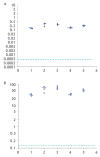Transfer of Silver Nanoparticles through the Placenta and Breast Milk during in vivo Experiments on Rats
- PMID: 24307938
- PMCID: PMC3848846
Transfer of Silver Nanoparticles through the Placenta and Breast Milk during in vivo Experiments on Rats
Abstract
Silver nanoparticles (NPs), widely used in the manufacture of various types of consumer products and for medical applications, belong to novel types of materials that pose potential risks to human health. The potential negative effects of the influence of these NPs on reproduction are insufficiently researched. A quantitative assessment of the transfer of metallic silver nanoparticles through the placenta and breast milk was carried out during an in vivo experiment. We used 34.9 ± 14.8 nm in size silver NPs that were stabilized by low-molecularweight polyvinylpyrrolidone and labeled with the (110m)Ag radioactive isotope using thermal neutron irradiation in a nuclear reactor. [(110m)Ag]-labeled NPs preparations were administered intragastrically via a gavage needle to pregnant (20(th) day of gestation) or lactating (14-16th day of lactation) female rats at a dose of 1.69-2.21 mg/kg of body weight upon conversion into silver. The accumulation of NPs in rat fetuses and infant rats consuming their mother's breast milk was evaluated using a low-background semiconductor gamma-ray spectrometer 24 and 48 hours following labeling, respectively. In all cases, we observed a penetration of the [(110m)Ag]-labeled NPs through the placenta and ther entry into the mother's milk in amounts exceeding by 100-1,000 times the sensitivity of the utilized analytical method. The average level of accumulation of NPs in fetuses was 0.085-0.147% of the administered dose, which was comparable to the accumulation of the label in the liver, blood, and muscle carcass of adult animals and exceeded the penetration of NPs across the hematoencephalic barrier into the brain of females by a factor of 10-100. In lactating females, the total accumulation of [(110m)Ag]-labeled NPs into the milk exceeded 1.94 ± 0.29% of the administered dose over a 48 h period of lactation; not less than 25% of this amount was absorbed into the gastrointestinal tract of infant rats. Thus, this was the first time experimental evidence of the transfer of NPs from mother to offspring through the placenta and breast milk was obtained.
Keywords: fetoplacental barrier; lactation; nanoparticles; pregnancy; radioactive tracer; silver.
Figures



References
-
- Vernikov V.M., Gmoshinski I.V., Khotimchenko S.A. Voprosy pitanija.. Problems of nutrition. 2009;78(6):13–20. - PubMed
-
- Blaser S.A., Scheringer M., Macleod M., Hungerbühler K.. Sci. Total Environ. 2008;390(2-3):396–409. - PubMed
-
- Bhol K.C., Schechter P.J.. Dig. Dis. Sci. 2007;52(10):2732–2742. - PubMed
LinkOut - more resources
Full Text Sources
